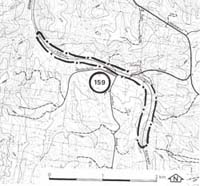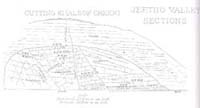159. Jeetho - Mesozoic Sections
|
This information has been developed from one or more of these publications:
|
Location: | Jeetho - 898490. Railway cuttings 81, 82, 90 on the South Eastern Railway 1.5 kilometres north-west of Bena. |  Mudstone bed containing plant fossils, South Eastern Railway at Jeetho. |
Access: | Walk along railway line from railway crossing at Jeetho. | |
Ownership: | Crown Land. | |
Geology: | Details of the Mesozoic rocks exposed by the cuttings were recorded by James Stirling (1890) shortly after the construction of the railway. His diagrams show faulted sandstone beds and record many with abundant plant remains. In cutting 82 is a 'Root and portion of trunk of tree 3 ft. diameter (inverted) probably deposited on sloping sandbank (Stirling 1892). The cuttings are now partly obscured by slumping, weathering of the beds and vegetation growth. | |
Significance: | Regional. This is one of several plant fossil locations known in cuttings on the South Gippsland Railway. The existence of detailed section drawings showing the interpretation of the structures in the nineteenth century is of interest for present comparison. | |
Management: | Class 1. No artificial stabilisation of the cuttings should be undertaken. | |




